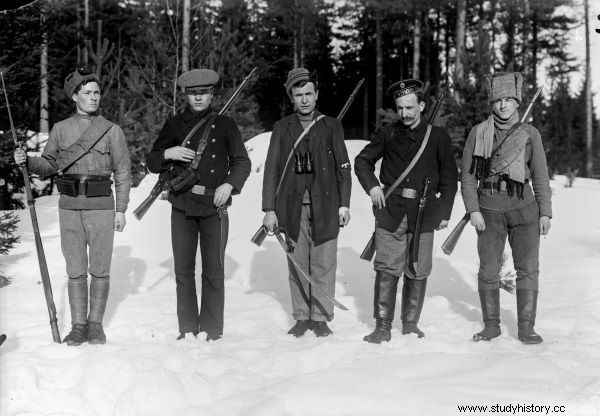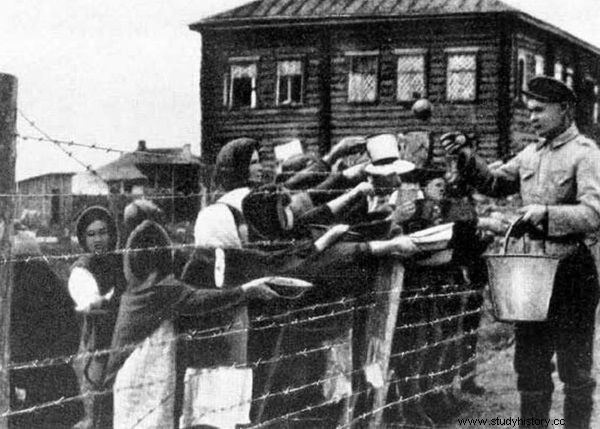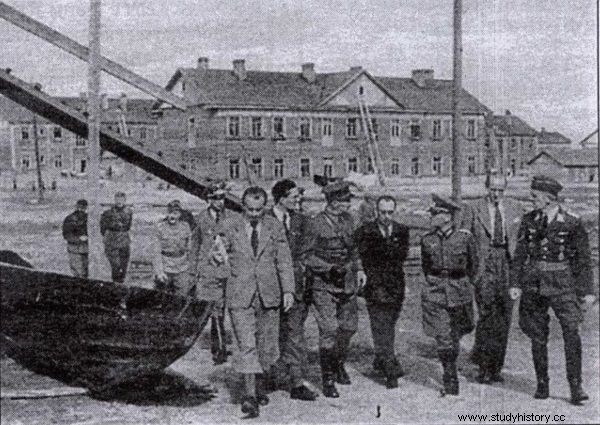Calm and restrained Finns, famous primarily for having their home of Nicholas, hide a dark secret. There were some formidable concentration camps in this beautiful country.
The statement "Polish concentration camps during the Second World War" drives Poles to white fever. We can directly say - it was the Germans who killed and tortured prisoners on the territory of our country, without our consent and cooperation in any field. Finns definitely don't have that luxury.
The Finns made the Finns this fate
The greatest enemy of the Finns, like the Poles, was geography. In their country, linked by a personal union with the Russian Empire, German and Russian influences clashed, which destabilized the situation. Carat was ruthlessly Russified first.

Russian orphans in a Finnish camp (colorization:Rafał Kuzak).
Later, when Finland regained its independence in the First World War and plunged into the civil war (January 27 - May 15, 1918), the Bolsheviks supported the red communist faction. The white monarchists emerged victorious from the conflict, and the fate of their opponents was unenviable.

Finnish Red Guards in 1918. When fighting, they did not expect the fate of their own people after the war.
Seeing the impending defeat, the Red Finns escaped to the neighboring Soviet country. Those who failed fell victim to a ruthless purge. Tens of thousands of citizens who took the wrong side in the civil war were imprisoned in concentration camps. About 80,000 people ended up in them.
More red people said goodbye to their lives in connection with the white terror than on the battlefields. The Finns spared neither women nor children.
The commander of the white armed forces, the national hero Carl Gustaw Emil Mannerheim, earned infamous nicknames, for example "The Executioner" or "The Butcher". According to his biographer Jonathan Clemens, 8,000 communists were shot as part of settling bills for a coup d'état. 364 women and as many as 58 children were murdered.
In captivity , 11,000 prisoners died within four months . There was such a hunger in the camps that the prisoners literally pounced on every plant. There was a real animalism. Inmate Viljo Sohkanen recalled:
One of the prisoners got a sausage in a package from home. He devoured it all, but then vomited it up in large chunks. The others immediately pounced on the sausage vomit.
The prisoners were in hell, while the day after the end of the civil war, victorious Mannerheim marched through Helsinki on horseback. The image of the triumph was completed by the white flowers thrown by the cheering crowd under his horse's hooves.
Starving Ruska
Two decades later, Finland was once again in a devastating war. During the Second World War, the Russian-Finnish conflict broke out twice. Stalin, despite the most sincere intentions, was unable to break the resistance of his inconspicuous neighbor. A small but fierce nation successfully faced an opponent that was many times stronger.

Captured red Finns in the town square of Tampere. They could not expect that statistically every tenth of them will not survive the captivity.
The natural consequence of any Finnish victories was the ever-increasing number of prisoners of war. They captured approximately 5,700 enemy soldiers during the Winter War, and approximately 64,000 during the Continuation War.
The prisoners from the first conflict could speak of a lot of luck in the context of subsequent events. Of these, only 135 seriously injured or sick died. Soldiers captured during the Continuation War found themselves in a much worse situation.
First of all, the Finns were surprised by their number. So much so that they had to hurriedly create over thirty new camps! Such hastily assembled facilities could not provide adequate conditions for the detention of thousands of prisoners. For a nation with few resources, it was also a huge challenge to have the right staff and sufficient food supplies. Nevertheless, the Finns, instead of freeing some of the prisoners, only looked for new ones. Also among civilians.
Old men, women and children
When the Finns occupied eastern Karelia, which belonged to the Soviet Union, during the Continuation War, a real nightmare began for the local population. A hell similar to the one that Mannerheim's countrymen had given their unreasonable compatriots two decades earlier. Old men, women and children were imprisoned in concentration camps.

Inmates of a Finnish concentration camp from the Second World War.
Famine and disease caused these people to die by the thousands. Eastern Karelia was inhabited by a conglomerate of various nations, with a large share of the Russian population. After the occupation of it by the Finns, about one third of the population of Slavic origin found themselves behind the barbed wire of the camps.
There was a similar method of dividing food in their area as in occupied Poland. On the Vistula River, the food rations granted by the Germans depended on ethnicity. The worse the "race", the smaller the allotment. The Finns came up with a similar idea, but in their country the worst treatment was not the Jews, but the Russians. Though they did not have an industry of death and the equivalent of a "final solution" on their territory, they were little worried about starvation in the winter of 1941-1942 of every seventh prisoner in the camps.
Finland was an ally of the Third Reich in World War II, though no formal agreement was reached. Due to this cooperation, there was one more type of camp on its territory - those built by the Germans. As Oula Seitnonen and Vesa-Pekka Herva write in their work on German prisoner-of-war camps in Finnish Lapland, Hitler's soldiers secured nearly 1,000 kilometers of front in the northern part of the country. Consequently, they built 100 camps in which they held approximately 30,000 prisoners.

The Finns show their German allies around camp 5 in Petropavlovsk in 1942.
Prisoners of war were used primarily as cheap labor. They were building, among other things, a railway line from Petsamo to Rovaniemi. We will look at postcards from a truly fairy-tale town in the far North in a completely different way, when we realize that this area is not only Santa Claus, elves and reindeer. There are also thousands of prisoners of war martyred in nearby camps.
***
The article was inspired by Katja Kettu's novel “Akuszerka”, which was published by the Świat Książki publishing house. The main character, Krzywe Oko, is a Finn who, following her love (a handsome German officer), volunteers to work in a POW camp. Katja Kettu gives the reader a unique chance to understand what life was like in Lapland after the Second World War.
